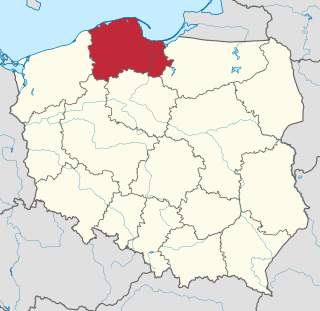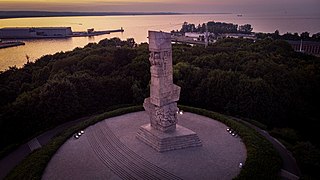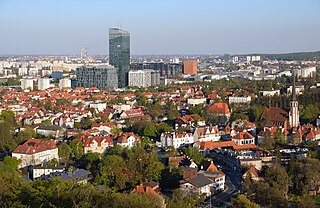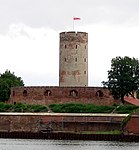
Gdańsk is a city on the Baltic coast of northern Poland, and the capital of the Pomeranian Voivodeship. With a population of 486,492, it is Poland's sixth-largest city and principal seaport. Gdańsk lies at the mouth of the Motława River and is situated at the southern edge of Gdańsk Bay, close to the city of Gdynia and resort town of Sopot; these form a metropolitan area called the Tricity (Trójmiasto), with a population of approximately 1.5 million.

Pomerania is a historical region on the southern shore of the Baltic Sea in Central Europe, split between Poland and Germany. The central and eastern part belongs to the West Pomeranian, Pomeranian and Kuyavian-Pomeranian voivodeships of Poland, while the western part belongs to the German states of Mecklenburg-Western Pomerania and Brandenburg.

Tczew is a city on the Vistula River in Eastern Pomerania, Kociewie, northern Poland with 59,111 inhabitants. The city is known for its Old Town and the Vistula Bridge, or Bridge of Tczew, which played a key role in the Invasion of Poland during World War II.

Pomeranian Voivodeship is a voivodeship, or province, in northwestern Poland. The provincial capital is Gdańsk.

Westerplatte is a peninsula in Gdańsk, Poland, located on the Baltic Sea coast mouth of the Dead Vistula, in the Gdańsk harbour channel. From 1926 to 1939, it was the location of a Polish Military Transit Depot (WST), sanctioned within the territory of the Free City of Danzig.

Port Island is an island located between Gdańsk Bay, Śmiała Wisła and Leniwka in northern Poland within the city limits of Gdańsk.

Gdańsk is one of the oldest cities in Poland. Founded by the Polish ruler Mieszko I in the 10th century, the city was for a long time part of Piast state either directly or as a fief. In 1308 the city became part of the Monastic State of the Teutonic Knights until 1454. Thereafter it became part of Poland again, although with increasing autonomy. A vital naval city for Polish grain trade, it attracted people from all over the European continent. The city was taken over by Prussia during the Second Partition of Poland in 1793 and subsequently lost its importance as a trading port. Briefly becoming a free city during Napoleonic Wars, it was again Prussian after Napoleon's defeat, and later became part of the newly created German Empire.

Oliwa is a northern district of the city of Gdańsk, Poland. From east it borders Przymorze and Żabianka, from the north Sopot and from the south with the districts of Strzyża, VII Dwór and Brętowo, while from the west with Matarnia and Osowa. It is known for its medieval monastery with the Oliwa Cathedral, the 1627 Battle of Oliwa and the 1660 Treaty of Oliva.

Nowy Port is a district of the city of Gdańsk, Poland. It borders with Brzeźno to the west, Letnica to the south, and Przeróbka to the east.

Śródmieście is a district (dzielnica) of the city of Gdańsk, Poland. Śródmieście is commonly referred to as Main City, Old City, or simply Gdańsk, since the quarter is equivalent to the traditional area of the city.

The Martwa Wisła is a river, which is one of the branches of the Vistula, flowing through the city of Gdańsk in northern Poland.

The Vistula Spit is an aeolian sand spit, or peninsular stretch of land, separating Vistula Lagoon from Gdańsk Bay, in the Baltic Sea, with its tip separated from the mainland by the Strait of Baltiysk. The border between Poland and Kaliningrad Oblast, an exclave of Russia, bisects it, politically dividing the spit into two pieces between the two countries. The westernmost geographical point of Russia is located on the Vistula Spit. The Polish part contains a number of tourist resorts, incorporated administratively as the town of Krynica Morska.

The Province of West Prussia was a province of Prussia from 1773 to 1829 and 1878 to 1919. West Prussia was established as a province of the Kingdom of Prussia in 1773, formed from Royal Prussia of the Polish–Lithuanian Commonwealth annexed in the First Partition of Poland. West Prussia was dissolved in 1829 and merged with East Prussia to form the Province of Prussia, but was re-established in 1878 when the merger was reversed and became part of the German Empire. From 1918, West Prussia was a province of the Free State of Prussia within Weimar Germany, losing most of its territory to the Second Polish Republic and the Free City of Danzig in the Treaty of Versailles. West Prussia was dissolved in 1920, and its remaining western territory was merged with Posen to form Posen-West Prussia, and its eastern territory merged with East Prussia as the Region of West Prussia district.

The Battle of Westerplatte was the first battle of the German invasion of Poland, marking the start of World War II in Europe. It occurred on the Westerplatte peninsula in the harbour of the Free City of Danzig.

Gdańsk Pomerania is the main geographical region within Pomerelia in northern Poland, covering the bulk of Pomeranian Voivodeship. In contrast to Pomerelia and its synonyms, the term does not cover the historical areas of Chełmno Land and Michałów Land, sometimes with the addition of Lubawa Land.

Krakowiec-Górki Zachodnie is one of the administrative districts in the city of Gdańsk.

The Vistula is the longest river in Poland and the ninth-longest in Europe, at 1,047 kilometres in length. Its drainage basin, extending into three other countries apart from Poland, covers 193,960 km2 (74,890 sq mi), of which 168,868 km2 (65,200 sq mi) is in Poland.

Wisłoujście Fortress is a historic fortress located in Gdańsk by the Martwa Wisła river, by an old estuary of the river Vistula, flowing into the Bay of Gdańsk. The fortress is located close to the Wisłoujście borough, Westerplatte and the Port Północny. It is listed as a Historic Monument of Poland.

The Westerplatte Monument, also known as the Monument to the Defenders of the Coast is a war memorial located in Gdańsk, Poland, on the Westerplatte Peninsula in the Gdańsk harbour channel constructed between 1964–1966 to commemorate the Polish defenders of the Military Transit Depot in the Battle of Westerplatte, one of the first battles in Germany's invasion of Poland, which marked the outbreak of World War II in Europe.

Stogi is one of the administrative districts of the city of Gdańsk, Poland. The district is the central part of the Port Island.























